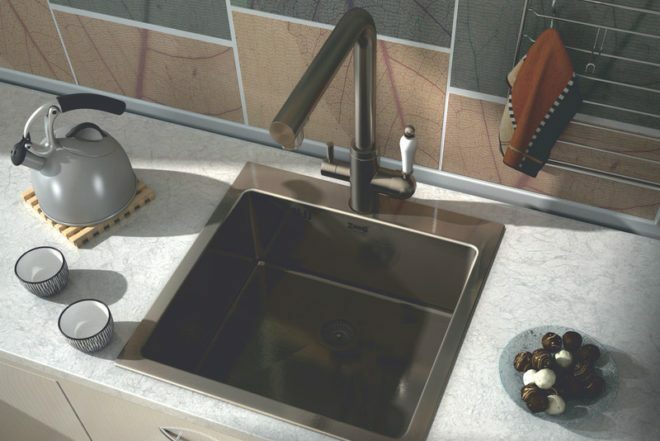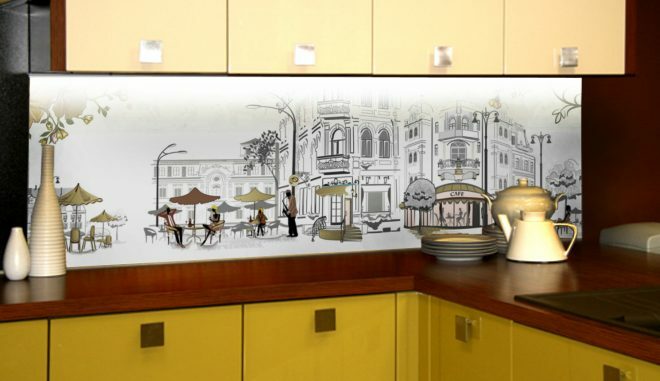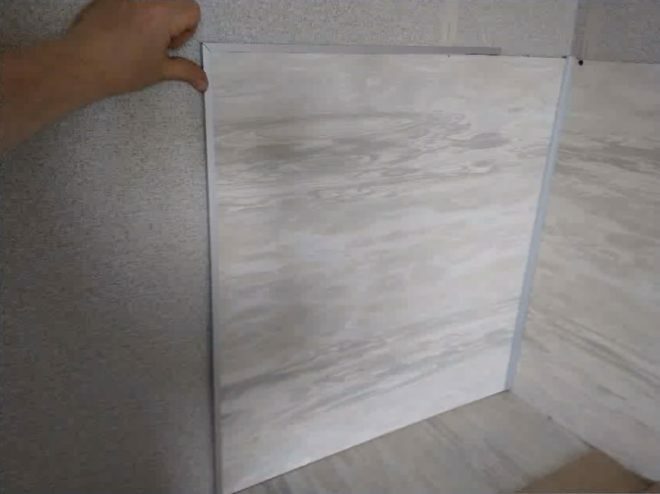The apron protects the walls in the work area from grease and dirt, steam and heat, while he is always in sight and is the first to throw eyes onentrance to the kitchen. Therefore, it should be, firstly, simply not killed, and secondly - beautiful. In this material we will tell you what aprons are, what pros and cons have different materials, as well as which apron to choose for the kitchen in design and size.
Material review
Ceramic tile
Ceramic tile - the most popular material for the decoration of the apron.
Pros: is easy to clean, durable, resistant to moisture, fire, alkalis and acids. The tile is eco-friendly and inexpensive. Among the ceramic tiles there is a large variety of shapes and sizes, textures and designs, and there are a great many ways of laying. The tile can be combined with any countertop, organically fit in both modern and classical interior. If desired, wall tiles can be laid independently.
Cons: apron from the tile has a weak place - the seams. If the tile itself is cleaned once or twice, then you have to mess with the grout and periodically update it. Another disadvantage is that the styling process is rather dirty and requires a smooth base.
Selection Tips:
- Bright tile + bright seams are an impractical combination, as over time the seams darken and look untidy.
- For an apron to be easily cleaned, give preference to a smooth matte tile, rather than glossy and / or embossed.
- To seal the seams of the apron from the tile you need to use waterproof grout intended for kitchens.
- For classic kitchens, square, small-format tiles are more suitable, as well as tiles with a pattern for majolica.

- The most universal design option for kitchen apron is a hog-size tile.
- Decorate simple tile apron with decorative inserts as shown in the photo below, borders and mosaic accents.

See more:
- How to choose a tile for an apron: 12 nuances and an overview of popular formats
- Apron made of hog tiles in the interior of an
kitchen mosaicthese materials at the same time. Sold mosaic already folded on the grid-matrix.



Pros: strength( especially smalt mosaics), the possibility of facing a curvilinear or simply not too flat surface, the possibility of making a complex and unique artistic composition.
Cons: a large number of seams, high price( higher than ceramic tiles), a little more complexity and high cost of installation, especially when laying a complex pattern.
Tips for choosing:
- If you want to save, use a mosaic in combination with ceramic tiles, such as in this interior in the photo below.

Combined kitchen apron of mosaic and tile
- Mosaic can replace the tile "under the mosaic", which is cheaper, and easier to fit.
See more: Everything about the kitchen apron from mosaic and even more.
Artificial and natural stone
Most often, tiles( slabs) made from natural / artificial granite or marble about 2 cm thick are used to finish an apron.
absorbs moisture and dirt. The color of the apron of granite can have a very different shade - gray-pink( the most common and inexpensive), yellow, blue, brown, red, black and almost white.
Granite Cons: high price, the need for professional installation. Granite purchased from an unscrupulous manufacturer may be radioactive.


Marble Pros: marble apron, perhaps the most beautiful. Domestic marble can cost relatively cheap.
Cons of a marble apron: marble has a high moisture absorption, because of which it absorbs grease and dirt. Glitter is lost over time, and some stains, for example, from rust or beet juice may simply not wash off.
Advantages of artificial stone( agglomerate): ease of care, durability, seamlessness of the finished apron, the variety of colors and textures, the possibility of restoration.
Cons of artificial stone: high price( higher than the porcelain, ceramics, glass).

Details in the material: Guide to the choice of artificial and natural stone for finishing the apron
MDF and chipboard
Using wood to finish the apron is not practical, not safe and expensive, so it is replaced with budget simulations - MDF or laminated chipboard. The thickness of such an apron can be from 4 to 15 mm. As a rule, MDF and chipboard are selected to the tabletop.


Pros: the ability to arrange an apron to match the wooden or stone countertops, low price, easy and quick installation even on a curved wall, ease of maintenance.
Cons: MDF and chipboard are not suitable for finishing the area behind the stove( especially gas), firstly, because of the high flammability, and secondly, because of the sensitivity to aggressive cleaning. Therefore, these materials are combined with a stainless steel insert or glass screen. Another drawback of MDF / chipboard apron is the presence of seams between the sheets, which are closed with moldings and corners, which complicates the cleaning of the kitchen and does not look too good.
See more: MDF wall panels in the decoration of the apron and kitchen walls.
Metal
Pros: matte and slightly textured stainless steel is very easy to clean. No scratches, no grease or cleaning products are not afraid of it. The apron from a stainless steel is very durable and wearproof.
Cons: polished( not matte) steel, though very beautiful, but not very practical, because it easily leaves fingerprints, drift marks and scratches. In addition, the metal apron is suitable only for modern kitchens.

Glass apron
To decorate the kitchen apron, not tempered glass is used, but tempered, as it is stronger on impact and safer. If you try hard and break the glass, then it will split not into sharp fragments, but into small and smooth pebbles. The glass apron is hung on special anchors with decorative plugs.
Cons: glass apron is made only to order just for individual sizes, cut it at the installation stage will not work. Installation is carried out only by professionals. Another significant drawback of glass is the high cost( from 5,000 rubles per square meter).
Pros: glass apron can be washed even with a brush and by any means, it does not scratch, is not afraid of fire, sunlight, temperature changes. Service life is about 10 years. Clear glass can be installed on top of “fragile” finishes, such as wallpaper or painted walls, photo collages or posters, masonry or wood.

And glass is also an excellent basis for photo printing. This apron is called skinali.

Skinali with a pattern in the interior of the kitchen-living room

Glass apron is made not only in the form of solid sheets, but also in the form of tiles, which can be folded in traditional ways, for example, as a “Christmas tree” in the following interior.
See more: Everything about glass aprons for the kitchen - from skins to Plexiglas.
Plastic apron
Plastic wall panels are a good solution for super-budget repairs or kitchen design in a rented apartment or cottage.

Pros: the main advantage is the low price, which allows you to frequently change the look of the apron. Plastic is easy to clean, can be mounted independently and even on a curved wall.
Cons: plastic apron is not compatible with a gas stove. It is also prone to scratches, abrasion and fading from sunlight. The service life of plastic is only a few years.
Tip:
- In Ikea, you can purchase a double-sided panel installed in special profiles. This apron can be changed independently every day.

See more: Apron made of plastic - information for the buyer.
How to choose the color and design of the kitchen apron
Here are a few tips to help you choose the appropriate design for the apron and fix some kitchen flaws:
- from materials as close as possible in color and texture. What else can you navigate when choosing a color and pattern of a kitchen apron? On the color and pattern of facades, walls, floors, curtains and other interior elements.

The blue apron is supported by the blue accents of the

Kitchen apron design echoes the wallpaper and facades of the
- Dark apron - the most impractical. Against such a background, dust, water droplets, and splashes of fat will be especially noticeable.
- When choosing a bright color or colorful design for the design of the apron, remember that the interior should be made neutral.
- Want to visually expand the small kitchen? Then decorate the apron so that it has as many horizontal lines as possible. For example, it can be striped or ceramic hog tiles.
- A mirror apron will help to increase the space and enhance the lighting of the kitchen. True, it is suitable only for those who rarely cook and rely on a beautiful appearance, because the mirror is very difficult to keep clean.

- The most appetizing food looks on a warm background, for example, orange, red, yellow.

We determine the height and size
The standard height of a kitchen apron is 60 cm, which is convenient for people of medium and high growth. However, if the majority of households are low, then the apron is better to make a height of 45-55 cm. We also recommend to slightly lower the height of the apron, if the upper cabinets are opened upward with the help of door closers. After all, if the opening of such doors is not difficult, then to close them, you have to stand on a stool or do it in a jump.

Low apron
For a kitchen set, partially or completely, without an attached cupboard, an apron can be made standard height or too high. For example, it may reach the ceiling or occupy approximately ¾ walls. Below are examples of aprons for kitchens without wall cabinets.
If desired, you can protect not only the area above the worktop and stove, but also the area behind the hood.

If the work area has a niche, then it is best to veneer it completely.

See more: The correct size of the apron is the secret of a convenient kitchen.
Photo Gallery












































